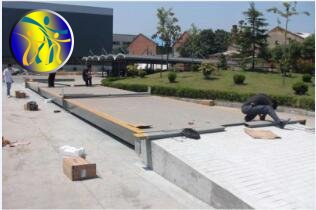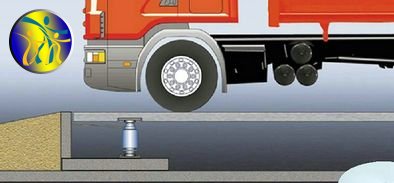 push date:Tue Aug 01 16:42:18 CST 2023
push date:Tue Aug 01 16:42:18 CST 2023
 popularity:
popularity:
 source:52
source:52
1、 The selection of installation location for electronic truck scales is crucial for achieving ideal weighing performance. The following experiences are summarized for reference by installers< a> 1. Thoroughly understand the soil pressure resistance, frozen layer, and water level at the installation site, confirm the suitability for installation locally, and then determine the specific construction plan< a> 2. The installation location should be away from powerful radio frequency interference sources, such as transmission towers for postal and telecommunications, television stations, etc< a> 3. Do not install near large substations< a> 4. The installation location should avoid high-voltage transmission lines. Electromagnetic and electrostatic coupling can cause interference between the transmission cable and the signal line of the electronic truck scale, and the longer the signal line, the stronger the interference. Wrapping a well grounded metal mesh protective tube around the signal line can theoretically suppress interference and improve weighing accuracy< a> 5. Equipped with an independent power supply to avoid sharing power with frequently started electrical equipment, high-power appliances, etc< a> 6. It has a relatively spacious installation site with sufficient space to construct a straight approach road, with a length approximately equal to the length of the scale body; Sharp turns are prohibited on the approach road. The gentle slope is designed to slow down the impact of the weight sensor when the car is weighing< a>
7. It is better not to install the electronic truck scale in the foundation pit in saline and alkaline areas, areas with heavy rainfall and moisture. If installation is necessary, consideration should be given to the ventilation, drainage, and maintenance space of the foundation pit< a> 8. The installation location should also consider the issue of wind direction, and try not to install the electronic truck scale on the "air vent". Otherwise, when the monsoon blows, the scale will not display stable and accurate readings< a> Practice has proven that selecting the correct installation location for electronic truck scales can fully leverage the high accuracy of electronic scales and improve their service life< a>Secondly, the 8 key points for the construction of the truck scale foundation

 1. The basic structure of the electronic truck scale (weighbridge) is divided into shallow foundation pit and no foundation pit. Our company provides design drawings for the user according to their needs< a> 2. Users can design construction drawings based on the provided basic design drawings and combined with the on-site geological conditions. In construction design, it is necessary to pay special attention to three issues:
1. The basic structure of the electronic truck scale (weighbridge) is divided into shallow foundation pit and no foundation pit. Our company provides design drawings for the user according to their needs< a> 2. Users can design construction drawings based on the provided basic design drawings and combined with the on-site geological conditions. In construction design, it is necessary to pay special attention to three issues:
(2) The foundation excavation must be excavated below the local frozen soil line< a> For shallow foundation pits, drainage channels must be designed. Even if there is no foundation pit, consideration should be given to surrounding drainage issues to ensure that the truck scale will not be submerged in water due to rain< a>
3. The vertical and horizontal steel mesh in the foundation concrete needs to be tied with 16 # iron wire at more than 50% of the intersection points, and connected to each iron base plate with steel bars (used as ground wires for weighing sensors)< a> 4. Embedded parts (such as iron base plates, anchor bolts, angle iron edge protectors, etc.) during foundation construction shall be provided by the user. Measures must be taken during construction to ensure the correct position of foundation bolts and iron base plates. Therefore, it is recommended to use the method of secondary grouting for positioning, and it is necessary to ensure that no voids are formed between the iron base plate and the concrete. During construction, it is necessary to ensure that the levelness and elevation of each iron base plate meet the requirements of the basic design drawings. The contour difference of the center of each iron base plate shall be less than 2mm, the horizontal inclination of the iron base plate shall be less than 1/500, and the diagonal deviation of the Centre-to-centre distance of each iron base plate shall be less than 2mm< a> 5. After the foundation construction is completed, attention must be paid to maintenance. To shorten the construction cycle and curing time, measures such as adding "early strength agent" to the concrete during construction are allowed. When the concrete does not reach the design strength, a weighing platform shall not be installed< a> 6. The design of the weighing room for the electronic truck scale is determined by the user according to their actual needs: a grounding wire and 220V power supply must be installed in the weighing room for use by the weighing control instrument. The weighing room must be close to the weighing platform, and special circumstances need to be informed in advance with our company< a>
III. Precautions for Sensor Installation and Use
1. InstallationThe installation base must have sufficient strength and rigidity, generally higher than the strength and rigidity of the sensor itself. The installation surface is flat, clean, and free of any oil film, adhesive film, etc. Leveling requirements: use a level to adjust the level of a single sensor, and then use a Dumpy level to adjust the installation plane of the mounting base of multiple sensors to a horizontal plane as far as possible to ensure that the load of sensors is consistent< a> During installation and transportation, to ensure that it is not damaged, it is necessary to handle it gently, especially sensors made of aluminum alloy. Any impact or drop may cause significant damage to their metrological performance. For large capacity weighing sensors, which have a large self weight, special tools should be used as much as possible< a>2. Loading
The loading direction of each type of sensor is fixed. When using, it is necessary to load in this direction and avoid lateral or additional torque forces. When installing sensors, try to use structural components with automatic positioning function, such as ball bearings, joint bearings, positioning fasteners, etc., to prevent lateral forces from acting on the sensor. It should be noted that some lateral forces are not caused by installation, such as expansion, wind, hard connections, vibrations, etc< a> Sensors should avoid overloading during use. Although sensors have a certain overload capacity, it is still necessary to avoid it during installation and use. Even in a short period of time, it may still damage the sensor. Sensors are generally equipped with overload protection devices during operation. (Column type sensors do not have)
3. Use environment
Try to seal it as much as possible to prevent garbage from affecting the sensor and its movable parts, and ensure sensor accuracy. In environments with corrosion and pollution, sensors need to undergo anti-corrosion treatment, such as applying anti-corrosion paint. The ambient temperature for sensor operation should be between -20~* 65 degrees< a> When using sensors, it is necessary to avoid overcurrent, such as welding current and lightning strikes, as well as strong radiation< a> The sensor signal cable cannot be arranged in parallel with the strong current power line or control line, and the spacing should be more than 50cm. The cable must also be covered with a metal tube. If the sensor cable needs to be extended, the joint must be welded and sealed to prevent moisture. The insulation resistance should reach (2000-5000 megohms) and the sensor should be recalibrated. The outgoing wire of the sensor must be a shielded wire, and the grounding connection of the shielded wire must be reliable, and the grounding should be less than 3 ohms< a>
To purchase car scale accessories - weighing sensors, please contact us at Guangzhou ZhongxinSales hotline:
Miss Chen: 18520271262
Miss Xie: 18688494254
Mr. Huang: 18688492451
Working hours:
Monday to Saturday9:0018:00
